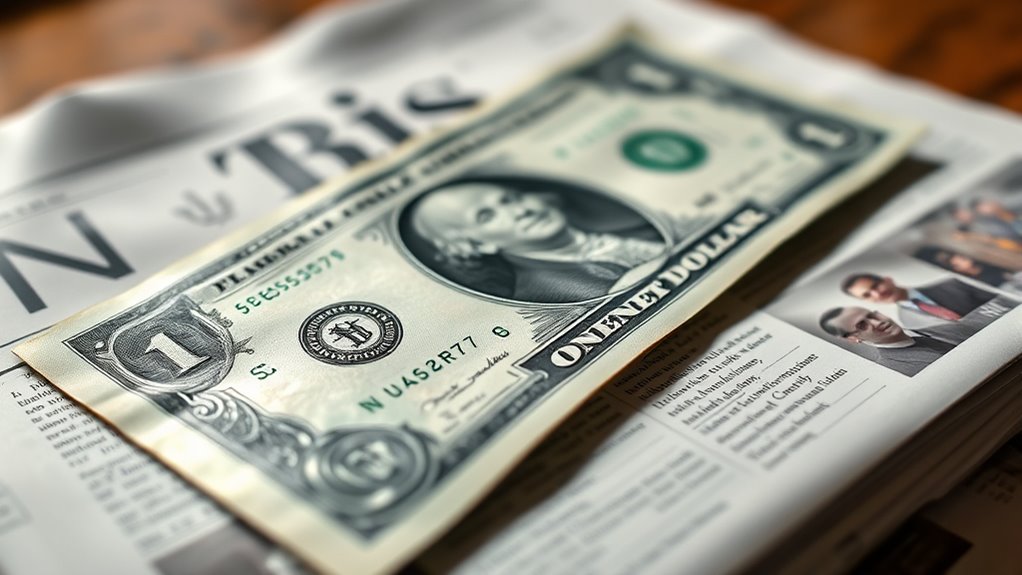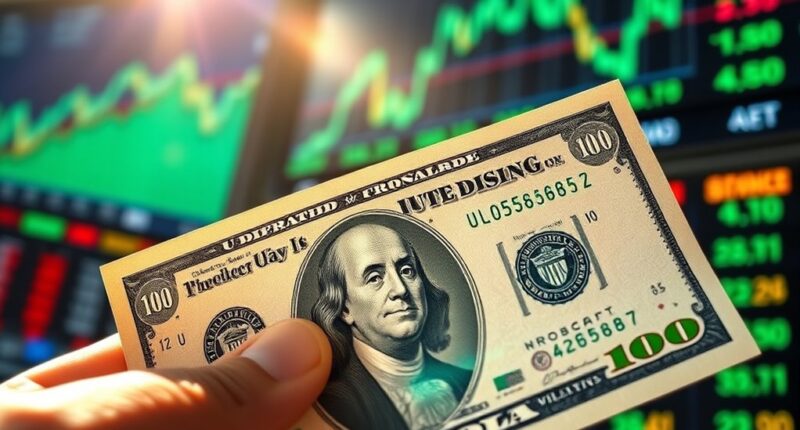When U.S. producer prices jump in July, it often pushes the dollar higher because markets see this as a sign of rising inflation. As wholesale costs increase across sectors, traders buy dollars to hedge against future price rises. This boost in the dollar reflects concerns about inflation and possible policy tightening by the Federal Reserve. If you want to understand how this impacts currency markets further, keep exploring the details behind these price changes.
Key Takeaways
- U.S. producer prices rose 0.9% in July, signaling mounting inflation pressures.
- The increase in wholesale costs led traders to buy dollars as a hedge against inflation.
- Rising core PPI suggests broad-based inflation across sectors, boosting dollar demand.
- Higher transportation and service sector prices contributed to the overall jump in producer prices.
- Market expectations of potential monetary tightening supported the dollar’s strength.

The U.S. dollar gained strength in response to a significant rise in producer prices in July, signaling mounting inflation pressures. This surge in the Producer Price Index (PPI) indicates that wholesale costs are increasing at a faster pace, which often foreshadows higher consumer prices down the line. When producer prices rise sharply, traders and investors interpret this as a sign that inflation could become more persistent, prompting them to buy dollars as a hedge against future price increases. The immediate result is a rally in the dollar’s value, as markets adjust to the new inflation signals.
In July, the PPI for final demand increased by 0.9% on a seasonally adjusted basis, marking the largest monthly jump since June 2022. This rapid increase reflects widespread cost pressures across various sectors, especially within services. The core PPI, which excludes food and energy, also grew by 0.9% monthly and 3.7% annually—surpassing economists’ expectations and suggesting that inflation is broad-based. The revision of June’s PPI from 2.3% to 2.4% underscores that inflationary forces are more persistent than initially thought. These figures point to a resilient inflation environment that could influence future monetary policy moves. Additionally, high vibrational energy can be crucial in manifesting desired outcomes, including economic stability.
Wholesale prices, which had been relatively subdued earlier in the year, now surged faster than anticipated, reigniting concerns about inflation passing through to consumer prices. Tariff-related cost increases, especially on imported goods, played a significant role in driving up wholesale costs. Businesses that previously absorbed some tariffs now seem less able to do so, which could translate into higher retail prices eventually. Service sector inflation contributed notably, with costs rising 1.1% month-over-month, driven partly by increased profit margins in equipment and machinery wholesaling. This indicates that inflation isn’t limited to goods but is also deeply embedded in services, adding to inflationary pressures.
Wholesale prices surged unexpectedly, with tariff hikes and rising service costs fueling broad inflation pressures.
The contribution from different sectors reveals that services accounted for most of the July PPI increase, with higher profit margins being a key factor. Goods prices did rise by 0.7% in July, the largest since January 2025, but this was still less than the increase seen in services. Additionally, stage 1 intermediate demand prices jumped 1.1%, the highest since August 2023, with broad-based input cost increases in securities brokerage, diesel fuel, data processing, and courier services. Some sectors, like pipeline transportation and natural gas, experienced declines, partially offsetting the overall rise.
Transportation costs, a significant component of producer prices, also increased notably. The Transportation Producer Price Index grew 1.9% from July 2024 to July 2025, with air transportation up 3.6% and rail up 1.4%. Conversely, truck and water transportation costs declined slightly. Rising transportation equipment and service costs elevate production expenses, which can filter through supply chains and contribute to future consumer inflation. These trends, combined with the overall PPI increase, keep inflation concerns front and center for markets and policymakers alike. Additionally, the rise in transportation costs signals ongoing inflationary pressures in logistics and shipping sectors, which could further influence overall inflation levels.
Despite the rising PPI figures, Federal Reserve officials continue to maintain their current monetary policy stance, emphasizing their focus on inflation control. However, the higher producer prices are likely to draw increased scrutiny from policymakers, as they may influence future interest rate decisions. Investors and traders interpret these inflation signals as a cue to strengthen the dollar, betting that the Fed might need to tighten monetary policy further if inflation persists. Overall, the jump in producer prices in July accentuates the ongoing inflationary challenge facing the U.S. economy and its impact on currency markets.
Frequently Asked Questions
How Does Producer Price Inflation Impact Consumer Prices Long-Term?
Producer price inflation impacts consumer prices long-term by gradually passing higher costs down the supply chain. When producers face rising costs, they often increase wholesale prices, which businesses then pass on to consumers. This process creates a lag, but persistent producer price increases usually lead to higher consumer prices over time. As a result, you’ll notice inflationary pressures in your everyday expenses, affecting your purchasing power and overall cost of living.
What Other Economic Indicators Influence the Dollar’s Strength?
You might think only interest rates drive the dollar, but many indicators matter. Strong U.S. economic growth, higher Treasury yields, and trade policies boost demand for the dollar. Conversely, rising public debt and global trade tensions can weaken it. Market sentiment, geopolitical risks, and safe-haven flows also influence the dollar’s value. Staying aware of these factors helps you understand the dollar’s unpredictable swings and protect your investments.
How Might This Price Jump Affect U.S. Interest Rate Policies?
This price jump suggests the Federal Reserve might hike interest rates to combat rising inflation, which could strengthen the dollar further. You should watch for signs of tighter policies, like rate increases or hawkish statements, as they aim to keep inflation in check. Higher rates attract foreign investment, boosting the dollar. However, continued inflation pressures could lead to prolonged or more aggressive rate hikes, impacting borrowing costs and economic growth.
Could Rising Producer Prices Signal Upcoming Inflationary Trends?
Yes, rising producer prices often signal upcoming inflationary trends. When costs for raw materials and transportation increase, businesses tend to pass these higher expenses to consumers, leading to higher retail prices. If this trend continues, you can expect inflation to pick up over the coming months. Keep an eye on how long these price pressures persist, as sustained increases usually indicate that consumer inflation may follow soon after.
What Are the Global Implications of a Stronger U.S. Dollar?
A stronger U.S. dollar affects you by making American goods more expensive abroad, which can reduce U.S. exports and hurt global trade. If you’re in an emerging market, you might face higher debt costs and capital outflows. Meanwhile, investments in U.S. assets could become more attractive, but currency volatility might increase. Overall, a strong dollar can slow worldwide economic growth and create financial instability across different regions.
Conclusion
You can think of the dollar as a rising tide, lifting everything in its path. When U.S. producer prices jump, it’s like adding fuel to that tide, making the dollar stronger. Just like a boat feels the pull of rising water, your investments and purchasing power can be affected by these shifts. Staying aware of these changes helps you navigate the economic waters, ensuring you’re prepared as the dollar continues to ripple upward.









